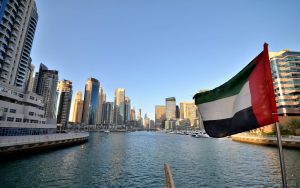Disclaimer: This article was first submitted in 2018 for a University course on “State and Transformation in the Middle East”.
Introduction
Among major contributions to the Rentier State Theory, Giacomo Luciani’s distinction between “production” and “allocation” states (1987) presents itself as a valuable instrument to analyse state-society dynamics as related to the availability of resources and the origin of state income. This article utilises Luciani’s framework for a comparative study of Saudi Arabia and Israel. Despite evident differences in political, cultural and economic terms, both countries are characterised by an extensive and highly discriminatory welfare system, which enables the state to exert considerable power over society. Whilst one would be tempted to characterise Israel as a production state and Saudi Arabia as an allocation state, the reality might be more nuanced. On the one hand, Saudi Arabia is gradually diversifying its productive capacity, in order to decrease oil dependency and boost its international competitiveness. On the other, the allocative function of the Israeli state is indeed rather unique in terms of magnitude and exclusionary nature, if compared to that of other production states. This analysis argues that, although the merely allocative state system is waning, the usage of welfare is still a powerful political tool, as it significantly aids the state in its capacity to both gain consensus and prevent waves of insurgency.
The first section of this analysis will illustrate the basic tenets of Rentier State Theory (RST), with particular focus on Luciani’s contributions. It will then discuss the politics of welfare, whereby the state operates a process of hierarchisation of different social groups.
The second section will apply such theoretical background to the context of Saudi Arabia, with regards to migrant labour and patterns of exploitation, passive citizenry and the structural transformations envisioned by the Vision 2030 project.
The last section will focus on Israel. After presenting its unique welfare system, the article will illustrate the politicisation of such system and its usage by the state, the stratification of citizenship and the stance towards immigration.
Production, distribution and the politics of welfare
First theorised by Iranian economist Hossein Mahdavy in 1970, the concept of rentier state defines such countries which, by relying primarily on external rents, are able to “embark on large public expenditure programmes without resorting to taxation” (Mahdavy 1970: 432). Such rents derive typically, albeit not exclusively, from oil exportation, thus mainly relating to GCC countries, as well as Libya and Venezuela. A state which collects its revenues from the external rent of indigenous resources need not rely on domestic income to thrive. It is thereby free to allocate its revenues to the population, primarily in the form of welfare provisions. Such is the allocative function of the state. Giacomo Luciani further contributes to RST by analysing the connection between resources and state resilience, and particularly the politics of oil. Unlike water, which is necessary for the survival of its consumers, oil is not important as such. It has value as a source of revenue, i.e. when it is exported outside of the state. This also underlines its intrinsically transnational dimension, as oil has the power to redefine global relations of power (Luciani 1987: 66-67).
Furthermore, Luciani distinguishes the structure of states according to the provenience of their income. An esoteric or “production state” raises the lion’s share of such income domestically, whereas an exoteric or “allocation state” originates at least 40 percent of it from the external rent of indigenous resources (ibid.: 69-70). The rentier state falls clearly within the latter category. A production state does also perform an allocative function, but it can only do so insofar as the domestic economy provides the necessary income, e.g. through taxation. For the allocation state, growth of the domestic economy is a “luxury” it buys with its external rents. For the production state, it is a necessary precondition for existence (ibid.).
For this analysis, it is crucial to consider the political implications of the rentier state model. Ross (as cited in Hanieh 2015a) identifies such implications in the political passivity of citizens given by the lack of taxation, the repressive tendency of governments due to their lack of accountability, and the poor development of rentier economies due to their dependency on external rents (Ross 2001: 327-8). Zeev Rosenhek defines the welfare state (i.e. a state which safeguards the socio-economic wellbeing of its citizens) as a mechanism which weakens “[…] the nexus between a person’s position in the market and his or her life chances”, meaning that it protects its citizens from being overly exposed to market competition (Rosenhek 1999: 197). However, the welfare state also determines the stratification of society, in that it creates a hierarchy of dominant and subordinate groups based on whom is entitled to the services it provides; such exclusionary processes are necessary to account for the rigidities the system creates in the labour market. In other words, welfare provisions allow dominant social groups to reject most humble jobs by providing them with, for example, unemployment subsidies. In order to make up for the resulting lack of labour, the welfare state needs groups who cannot access its benefits (which are usually unskilled immigrants) and are thus dependent on market forces. These groups’ only chance for survival is therefore to take the jobs rejected by the dominant group, often on exploitative wages (ibid.).
Such framework is particularly important when applied both to Saudi Arabia and Israel, albeit in different ways. In the next two sections, this article demonstrates how simply labelling Saudi Arabia an allocation state and Israel a production state would overlook significant nuances of both state structures.
Saudi Arabia: social hierarchy, exploitative labour and transformation
Rosenhek presents his analysis of the welfare state as pertaining to the sphere of “advanced capitalist societies” (Rosenhek 1999: 210). This article argues that such framework is also applicable to the case of Saudi Arabia, in light of Hanieh’s analysis of “Gulf capitalism” (Hanieh 2015a: 4-5) and the aforementioned transnational dimension of oil politics. The rise of the Saudi role in the global economy determined the emergence of a global-tied “capitalist class” in which state ruling elites intertwined with representatives of large private corporations, from old merchant families as well as newly established social groups (ibid.: 6). Such dynamics of privilege also spurred regular citizens to pursue relations of patronage with the capitalist class, thus engendering a structure of “vertical segmentation” (Khalaf 1998, as cited in Hanieh 2015a) which discourages cross-group cooperation, national sentiments and the consolidation of a strong civil society.
Such fragmented social structures provide a fertile ground for the mentioned discriminatory politics of welfare. The Saudi state discriminates highly between citizens and non-citizens: whilst the former benefit from extensive welfare provisions (Al-Araby 2017) and are usually employed by the state, the latter mainly work in the private sector, with no minimum wage and often under exploitative conditions (Hanieh 2015b: 66). Following the oil price boom in the 1970s, Gulf countries encouraged mass labour migration to sustain rapid urban and infrastructural development with cheap workforce. First mass migration flows came mostly from other Arab countries: naturalisation policies of Arab immigrants implemented by the Gulf states in the 1960s and 1970s were though soon abandoned because of Saudi fears about such immigrants forming transnational networks of pan-Arab activism. From the 1980s onwards, Saudi preference shifted towards non-Arab immigrants from South and Southeast Asia (Thiollet 2011: 107). As non-citizens, migrant workers in Saudi Arabia fall well outside of the purview of the welfare state, and are thus compelled to enter circles of exploitation and labour precariousness. This is best exemplified by the kafala system: such arrangement binds the migrant worker to a kafeel, a Saudi citizen appointed by the state who prevents the worker from seeking a job elsewhere. Besides embodying a “slave-like structure, which ties the migrant to the national” (Azhari 2016-17: 68), such system constitutes a source of patronage relations between the kafeel and the ruling elite (Hanieh 2015a: 7).
It becomes thus clear how the Saudi state utilises welfare to exert control over its resident citizen and non-citizen population. By dispensing benefits, formally through welfare, informally through patronage, to citizens, it secures political consensus. By denying benefits to non-citizens, it lowers the risk of insurgency, as foreign workers are pushed to abide by the rules for fear of losing their job. However, recent trends signal substantial changes in the Saudi society and, broadly speaking, in the whole Gulf Cooperation Council (GCC). The disproportionate reliance on foreign workforce, along with the “rentier mentality” breaking the work-reward equation for citizens free-riding on state subsidies (Beblawi 1987: 52) caused staggering levels of youth unemployment, currently amounting to 34.6 percent of 15 to 24-year-old Saudis (World Bank 2018). GCC countries altogether are very aware of the dangers of oil dependency, exposed dramatically by the recent collapse in Venezuela (Wald 2017); transformations occurring in the Gulf are precisely aimed at shifting away from the allocation state structure. Such trends are embodied in Saudi Arabia by the Vision 2030 development plan, spearheaded by Crown Prince Mohammed bin Salman (Rashad 2016): because of its commitment to greater economic openness through a reformist secular agenda, the plan was met by rather conflicting reactions coming from the different strata of Saudi society (ibid.). Vision 2030’s “Fiscal Balance Program” aims at diversifying revenue sources through a substantial increase in taxation. Such fiscal policies include: an “expat levy” to enterprises hiring more expatriates than Saudi citizens, aimed at encouraging Saudisation of labour and reduce domestic unemployment; a value-added tax, implemented regionally by all GCC countries according to a 2017 agreement (GCC 2017), which is expected to be one of the major sources of non-oil revenues; an excise tax on commodities such as luxury items, tobacco and energy drinks (Kingdom of Saudi Arabia 2018). Along with policies of productivity enhancement presented by Vision 2030, the Fiscal Balance Program clearly signals the Saudi shift from a purely allocative state system to a more productive one, in that it intends to finance welfare provisions by partly relying on domestic collection of state income.
Israel: intra-citizenship allocative discrimination in a thriving economy
To this day, Israel exhibits a largely market-based economy, an entrenched taxation system and a strong private sector, all features which clearly mark its conformity with the production state model. However, Israel has relied since statehood on substantial amounts of foreign aid, which could well be considered a source of external rent (Luciani 1987: 72). Such aid was initially provided by West Germany as a compensation for the Holocaust (Frohn 1991: 3), and then mainly by the United States. Israel is now “the largest cumulative recipient of U.S. foreign assistance since World War II”, with an overall amount of $134.7 billion (Sharp 2018). Moreover, the extensive welfare system first built by Ben Gurion’s centre-left Mapai party (Eisenstadt and Ahimeir 1985: 251-4) eloquently witnesses the magnitude of the state’s allocative function.
Scholarly contributions in the field have stressed the unique stance the Israeli welfare system has towards immigrants, in that “poverty levels among immigrants in Israel tend to be lower than or on par with those of the general population” (Gal 2008: 650). Clearly, such claims only refer to olim (i.e. immigrants on Aliyah). The constituent laws of both Israel and Saudi Arabia emphasise the respectively “Jewish” and “Arab Islamic” nature of the state (Knesset 2003; Saudi Arabia 1992), identifying it in ethnoreligious terms. Unlike Saudi Arabia, Israel’s hierarchisation of residents establishes a de jure stratified citizenship which significantly downplays political representation of Arab citizens. According to Rosenhek, such discrimination policy is furthered by the welfare state. This is best exemplified by the child allowance scheme, which is part of Israel’s social security system and provides families with children with cash benefits (1999: 198). Rosenhek illustrates two phases of exclusion of Arab Israelis from such scheme: a first “informal” phase in the 1960s, during which scarce information about the program was spread in mostly Arab villages in Israel, and a second “formal” one, in which such exclusion was codified and officially implemented. Such phase begins with the “Veterans’ Families Allowance Program” (introduced in 1970), according to which only families with at least one member who served in the army were entitled to the program. This excluded Arabs as well as Haredi Jews, so the Ministry of Religious Affairs provided alternative programs for the latter. No programs were conceived for Israeli Arabs (ibid.: 206).
Israel also takes a quite unique stance on immigration. Clearly, it encourages Jews from all over the world to make Aliyah, granting newcomers immediate citizenship (according to the 1950 Law of Return) and generous welfare provisions (Nefesh B’Nefesh 2018). In the past, Israel experienced several major waves of Oleh migration. The last one has been that from the former Soviet Union (FSU) in 1990, which by 1994 had already increased Israel’s population by 12 percent (Friedberg 2001: 1373). Such wave also raised controversies, in that one-third of such migrants had a non-Jewish spouse (Rozenholc 2010: 4). Besides Aliyah, non-citizen labour in Israel was until the 1990s mainly made of Palestinians from the West Bank and Gaza, who obtained work permits into Israel and were generally not allowed to stay overnight (ibid.: 3). The increasing violence after the onset of the First Intifada and the arrival of masses of highly skilled Jews from the FSU, who did not want to take “Arab jobs” (Bartram 1998: 310), led to the decision to import foreign workers from outside of the region (mainly Africa and Southeast Asia) as a response to the lack of housing for Aliyah newcomers. Besides construction, foreign workers are generally hired in agriculture or as care-givers and cleaners (Rozenholc 2010: 2). Discrimination against such workers is undoubtedly rooted in the need to preserve a Jewish majority within the state. Like Palestinians, they are commonly perceived as a threat to Israel’s Jewishness. As non-Jewish residents of Israel, children of such foreigners are not allowed to serve in the army. This perpetuates the message of “not belonging” even to second-generation immigrants (Morris 2018). As in the case of the “Veterans’ Families Allowance Program” mentioned above, conscription plays here the same exclusionary role as the welfare state.
Conclusion
Te latter section of this analysis sheds light on the shortcomings of a merely allocative state system, primarily that of depending, in its most traditional form, on a single commodity with fairly volatile prices. The transformative processes occurring throughout the GCC (raising productivity, taxation, openness to international markets) are precisely rooted in the awareness of such shortcomings. However, the shrinking allocative function of the state, together with rising commodity prices due to the increasing privatisation, may have serious consequences on the governments’ grip on society. Policies of Saudisation of labour could be interpreted in this framework as a new but equally divisive interpretation of welfare; the fall of government subsidies to citizens will be compensated by the increase of jobs for Saudi youth, which is in turn likely to increase mass deportation of foreign workers to rebalance demographic proportions, an already well-established practice in Israel. Be that as it may, both case studies presented clearly illustrate the divisive potential of the welfare system, which operates a colonialist “divide et impera” policy of privilege and exclusion and constitutes thereby an effective tool for the hierarchisation of society. Given its effectiveness, it is unlikely of such practice to change in the near future.
Sources
Al-Araby (2017) Half of Saudi Arabia’s population are receiving welfare payments, Al-Araby. 22 December 2017, available at goo.gl/ixqANj (accessed 22 April 2018).
Azhari, A. (2016-17) ‘The Kafāla Sponsorship System in Saudi Arabia: a Critical Analysis from the Perspective of International Human Rights and Islamic Law’, The SOAS Journal of Postgraduate Research 10: 61-80.
Bartram, D. (1998) ‘Foreign workers in Israel: History and Theory’, International Migration Review 32(2): 303-325.
Beblawi, H. (1987) ‘The Rentier State in the Arab World’, in: The Rentier State, London: Croom Helm, 49-62.
Constitute Project (2018) Saudi Arabia’s Constitution of 1992 with Amendments through 2005, available at goo.gl/6tEhNr (accessed 22 April 2018).
Eisenstadt, S. and Ahimeir, O. (1985) The Welfare State and Its Aftermath, Totowa (NJ): Barnes & Noble Books.
Friedberg, R. (2001) ‘The Impact of Mass Migration on the Israeli Labor Market’, The Quarterly Journal of Economics: 1373-1408.
Frohn, A. (1991) ‘Holocaust and Shilumim: The Policy of Wiedergutmachung in the Early 1950s’, German Historical Institute 2: 1-7.
Gal, J. (2008) ‘Immigration and the Categorical Welfare State in Israel’, Social Service Review 82(4): 639-661.
Gulf Cooperation Council (2017) Common VAT Agreement of the States of the Gulf Cooperation Council (GCC), available at goo.gl/Lv8RGS (accessed 22 April 2018).
Hanieh, A. (2015a) ‘Capital, Labor, and State: Rethinking the Political Economy of Oil in the Gulf’, The Oxford Handbook of Contemporary Middle-Eastern and North African History: 1-15.
Hanieh, A. (2015b) ‘Overcoming Methodological Nationalism: Spatial Perspectives on Migration to the Gulf Arab States’, in: Transit States: Labour, Migration and Citizenship in the Gulf, Pluto Press: 57-76.
Khalaf, A. (1998) ‘Contentious Politics in Bahrain: from Ethnic to National and Vice Versa’, in: Fourth Nordic Conference on Middle Eastern Studies: The Middle East in a Globalizing World, Oslo.
Kingdom of Saudi Arabia (2018) ‘Fiscal Balance Program: 2018 Update’ Vision 2030.
Knesset (2003) The Declaration of the Establishment of the State of Israel, available at goo.gl/Y6Jzhu (accessed 22 April 2018).
Luciani, G. (1987) ‘Allocation vs. Production States: A Theoretical Framework’, in: The Rentier State, London: Croom Helm, 63-82.
Mahdavy H. (1970) ‘The Patterns and Problems of Economic Development in Rentier States: The Case of Iran’, in: Studies in the Economic History of the Middle East, Oxford: Oxford University Press, 428-467.
Morris, L. (2018) The future of Israel’s ‘dreamers’, Washington Post. 5 March 2018, available at goo.gl/wL6RDN (accessed 22 April 2018).
Nefesh B’Nefesh (2018) Aliyah Benefits for Olim Chadashim, available at goo.gl/SsggXc (accessed 22 April 2018).
Rashad, M. (2016) Saudis await prince’s vision of future with hope and concern, Reuters. 24 April 2016, available at goo.gl/ekvSkM (accessed 22 April 2018).
Rosenhek, Z. (1999) ‘The Exclusionary Logic of the Welfare State’, International Sociology 14(2): 195-215.
Ross, M. (2001) ‘Does Oil Hinder Democracy?’, World Politics 53: 325-361.
Rozenholc, C. (2010) ‘Foreign Workers, the Impact of a Non-Jewish Migration on Israeli Citizenship’, Bulletin du Centre de recherche français à Jérusalem 21: 1-7.
Sharp, J. (2018) ‘U.S. Foreign Aid to Israel’, Congressional Research Service 7: 1-28.
Thiollet, H. (2011) ‘Migration as Diplomacy: Labor Migrants, Refugees, and Arab Regional Politics in the Oil-Rich Countries’, International Labor and Working-Class History 79: 103-121.
Wald, E. (2017) Venezuela’s Melt Down Explained By The ‘Oil Curse’, Forbes. 16 May 2017, available at goo.gl/63pRp2 (accessed 22 April 2018).
World Bank (2018) Unemployment, youth total (% of total labor force ages 15-24): Saudi Arabia, available at goo.gl/tpm5XL (accessed 22 April 2018).









Be First to Comment